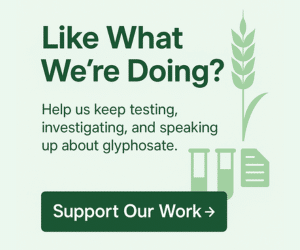No More Glyphosate NZ
218 POSTS0 COMMENTS
No More Glyphosate NZ is a grassroots campaign dedicated to raising awareness about the health and environmental risks of glyphosate use in New Zealand. Our mission is to empower communities to take action, advocate for safer alternatives, and challenge policies that put public safety at risk. Join us in the fight to stop the chemical creep!
One Less Kidney: When Everyday Exposure Hits Home
When everyday exposure meets real life: one family’s fight with kidney cancer brings glyphosate’s risks into sharp focus. How safe are “safe limits” when lives are on the line?
Six Months On — and We’re Only Just Getting Started
Six months after launching to challenge MPI’s proposal to raise glyphosate residue limits, NoMoreGlyphosate.nz looks back on testing results, public pressure, and a collective effort that made a real difference — and why the next six months matter even more.
We Read the Glyphosate Submissions Summary—Here’s What Really Changed (and What Didn’t)
NZ Food Safety’s summary of glyphosate submissions keeps cereals at 0.1 mg/kg and bans pre-harvest use. A win worth celebrating — but with loopholes on animal feed, weak enforcement, outdated diet data, and Roundup® co-formulants, the fight for real food safety isn’t over.
Public Pressure Keeps Glyphosate Limits Low — But Who’s Enforcing the Rules?
Public pressure worked: glyphosate residue limits for wheat, barley, and oats will stay at 0.1mg/kg in New Zealand. Pre-harvest spraying is banned — but enforcement remains the real test.
Can You Really Detox Roundup From Your Body?
Glyphosate-based weedkillers — best known under the brand name Roundup® — are woven into the fabric of modern agriculture.
They’re sprayed on food crops...
One Woman’s Story of Lost Taste and Smell. It Wasn’t Just the Potato
For two years, she lived without taste or smell. At first it seemed like an allergy to potatoes — until an organic test revealed the truth. The problem wasn’t the potato at all, but glyphosate-based sprays like Roundup. This personal story shows how hidden chemical residues can affect our health in unexpected ways.
Glyphosate is a Hazardous Substance — Yet Roundup Hides in Plain Sight
Glyphosate is officially a hazardous substance under NZ law. Yet Roundup — more toxic than glyphosate alone — hides in plain sight with soft labels and missing warnings. Hazardous by law, invisible by label.
Feeling Glyphosate Before Seeing It: What Lived Experience Tells Us
Some people say they feel glyphosate before they even see the yellowed grass — headaches, pain, and liver stress acting as early alarms. Science is beginning to show those “silent signals” may not be coincidence.
Does Glyphosate Really Cause Cancer?
Does glyphosate really cause cancer? A 2023 review shows strong biological red flags, while human studies point to non-Hodgkin lymphoma. Regulators disagree, but the evidence is mounting—and the question remains: why are we still taking the risk?
High Court Sides with Environmental Protection Authority on Glyphosate
When the High Court sided with the EPA over glyphosate, it wasn’t a win for science — it was a win for procedure. If regulators and courts won’t protect us, who will?
Who’s Protecting Our Food? The Minister’s Duty of Care on Glyphosate
MPI claims to test food for chemical contaminants, but glyphosate — New Zealand’s most widely used pesticide — is missing. Oversight or by design? If the Minister for Food Safety isn’t monitoring glyphosate, who’s protecting our children’s food?
Ghostwritten Science: How Industry Tilted the Glyphosate Debate
Glyphosate’s EU approval was rocked by revelations of ghostwritten papers, copy-paste assessments, and industry infiltration of committees. This isn’t just about the chemical — it’s about whether we can trust the process itself.



